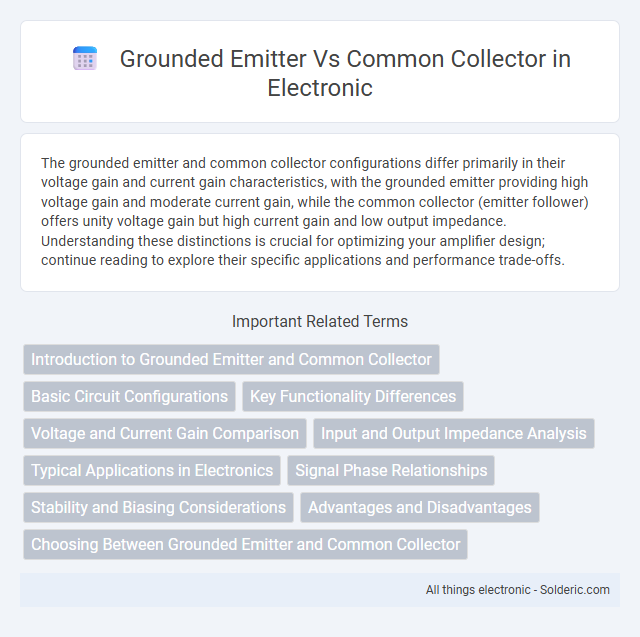The grounded emitter and common collector configurations differ primarily in their voltage gain and current gain characteristics, with the grounded emitter providing high voltage gain and moderate current gain, while the common collector (emitter follower) offers unity voltage gain but high current gain and low output impedance. Understanding these distinctions is crucial for optimizing your amplifier design; continue reading to explore their specific applications and performance trade-offs.
Comparison Table
| Parameter | Grounded Emitter | Common Collector |
|---|---|---|
| Configuration | Emitter terminal connected to ground | Collector terminal common to input and output |
| Voltage Gain | High voltage gain (>1) | Voltage gain ~1 (unity) |
| Current Gain | Moderate current gain (>1) | High current gain (>1) |
| Input Impedance | Low input impedance (hundreds of ohms) | High input impedance (kilo-ohms) |
| Output Impedance | High output impedance (kilo-ohms) | Low output impedance (tens of ohms) |
| Phase Shift | 180 degrees | 0 degrees (no phase inversion) |
| Usage | Voltage amplification | Impedance matching, buffer stage |
Introduction to Grounded Emitter and Common Collector
Grounded emitter and common collector are two fundamental transistor configurations used in amplifier circuits. Grounded emitter, also known as common emitter, provides high voltage gain and phase inversion, making it ideal for amplification tasks requiring significant signal boosting. Common collector, or emitter follower, offers high input impedance and low output impedance, providing excellent current gain and signal buffering for improved impedance matching in your circuits.
Basic Circuit Configurations
Grounded emitter and common collector are fundamental transistor configurations used in analog circuits. A grounded emitter configuration, also known as common emitter, provides voltage gain and phase inversion, making it ideal for amplification tasks. In contrast, the common collector, or emitter follower, offers high input impedance and low output impedance, suitable for impedance matching and buffering in your circuit designs.
Key Functionality Differences
Grounded emitter configuration provides high voltage gain and is commonly used as a voltage amplifier, while the common collector configuration offers high current gain and is primarily utilized as a buffer or impedance matcher. Grounded emitter circuits invert the input signal and have moderate input impedance with low output impedance, contrasting with common collector circuits that maintain signal phase and exhibit high input impedance with low output impedance. These key functionality differences dictate their specific applications in amplifier design and signal conditioning tasks.
Voltage and Current Gain Comparison
A grounded emitter configuration provides high voltage gain but moderate current gain, making it ideal for voltage amplification applications. The common collector, also known as an emitter follower, offers a voltage gain close to unity while delivering high current gain, effectively acting as a buffer to drive low-impedance loads. Understanding these differences helps you choose the right transistor configuration for your circuit's voltage and current requirements.
Input and Output Impedance Analysis
Grounded emitter configurations exhibit low input impedance, typically ranging from a few hundred ohms, due to the emitter being connected directly to ground, which makes them well-suited for voltage amplification but limits their input signal strength. Common collector stages, also known as emitter followers, display high input impedance, often in the order of tens of kilo-ohms or higher, as the input is applied at the base while the output is taken from the emitter, providing impedance matching and buffering capabilities. Output impedance in grounded emitter circuits is moderately high, ideal for driving low-impedance loads, whereas common collector outputs present very low impedance, often below a few ohms, enabling them to drive heavy loads with minimal signal loss.
Typical Applications in Electronics
Grounded emitter configurations are widely used in amplifier circuits due to their high voltage gain, making them ideal for signal amplification in audio and radio frequency applications. Common collector setups, also known as emitter followers, provide high input impedance and low output impedance, which are essential for impedance matching and buffering in voltage regulation and sensor interface circuits. Your choice between grounded emitter and common collector depends on whether voltage gain or impedance matching is the priority in your electronic design.
Signal Phase Relationships
A grounded emitter configuration produces an output signal that is inverted, resulting in a 180-degree phase shift between input and output. In contrast, the common collector configuration, also known as an emitter follower, provides an output signal that is in phase with the input, featuring no phase inversion. This phase relationship distinction is crucial in amplifier design and signal processing applications.
Stability and Biasing Considerations
Grounded emitter configurations offer high voltage gain but exhibit less thermal stability and require precise biasing to maintain consistent operation. Common collector (emitter follower) circuits provide superior stability and maintain a constant voltage gain close to unity, making biasing more straightforward and less sensitive to temperature variations. Your choice between these configurations hinges on the need for gain versus stability and the complexity of biasing requirements in your application.
Advantages and Disadvantages
A grounded emitter configuration offers high voltage gain and improved input impedance, making it suitable for voltage amplification, but suffers from lower input impedance and phase inversion. The common collector configuration provides high input impedance and low output impedance, ideal for impedance matching and buffering, though it offers no voltage gain and only current gain. Your choice depends on whether voltage amplification or impedance matching is the primary requirement in your electronic circuit design.
Choosing Between Grounded Emitter and Common Collector
Choosing between a grounded emitter and a common collector configuration depends on your requirements for voltage gain, input impedance, and output characteristics. Grounded emitter amplifiers provide high voltage gain and moderate input impedance, making them ideal for signal amplification in RF and audio circuits. Common collector amplifiers offer high input impedance and low output impedance, serving best as voltage buffers to match impedance without voltage gain.
Grounded emitter vs Common collector Infographic

 solderic.com
solderic.com